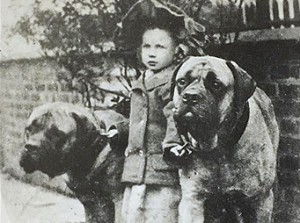The Bullmastiff – The Keeper’s Night Dog
134 – March 2019
By Lee Connor
 Anyone delving into the rather murky history of the Bullmastiff will frequently encounter lines like this:
Anyone delving into the rather murky history of the Bullmastiff will frequently encounter lines like this:
‘The original Mastiff of Britain is one of the country’s oldest breeds, but its descendant, the Bullmastiff, is a comparatively recent development.’
Usually the text will go on to point out, quite rightly, that the breed was only officially recognized by the KC in 1924.
However, simply by looking at its various appearances in paintings, photographs and reading historical references to the ‘breed’, the hard evidence seems to completely refute this widely held belief.
A very stable ‘Bullmastiff’ type quite obviously occurred long before its recognition in 1924.
One of the first of the possible early references to it appears in an advertisement taken from the Manchester Mercury 1785, which reads: ‘Taken up on the road between Huddersfield and Marsden on Sunday, 15th November, a large light-coloured dog between the bull and mastiff kind.’
Buffon stated in 1791 that the cross between a Bulldog and Mastiff produced, ‘A strong large Bulldog, much larger than a Bulldog but more like one of that breed than a Mastiff.’
None other than ‘Stonehenge’ in his ‘The Dogs of the British Islands’ devotes a chapter to the ‘The Keeper’s Night Dog’ and whilst not naming the dogs he describes as ‘Bullmastiffs’, he does reference ‘bull crosses with the mastiff’ as being be- hind the perfect keeper’s night dog.
This paragraph is also very interesting:
‘…a Mastiff crossed with the Bloodhound, is the dog a keeper (gamekeeper) generally prefers; but the men have their own ideas on the subject, and generally know pretty well where to obtain a promising young dog from each other for very little money. As there is not much demand for them, those keepers who breed them seldom save more than a couple in a litter, and consequently they are for the most part vigorous examples and large; indeed, power and a certain happy combination of ferocity and intelligence are the chief requisites in a night dog.’
Click here to read the complete article134 – March 2019

Short URL: https://caninechronicle.com/?p=160068
Comments are closed











